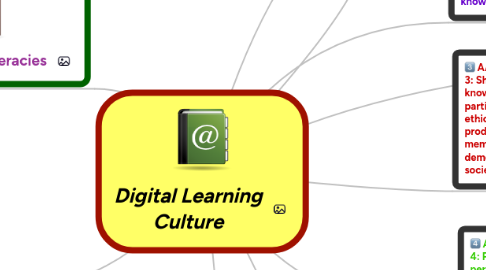
1. Community Involvement
1.1. everyone participates
1.2. literacy shift
1.3. interrelationships
1.4. technologies interact
2. Hot Issues
2.1. access to technology
2.1.1. have or have nots
2.1.2. wifi not available everywhere
2.2. exposure online unlimited
2.2.1. protection a must
2.2.2. cyberbullying
2.2.3. information overload
2.3. online ethics dilemmas
2.3.1. audience is unlimited
2.3.2. unknown/false identities
2.3.3. too many choices
3. New Scope of Literacies
3.1. combine aural, visual, digital
3.2. adaptations
3.3. dynamic images
3.4. dynamic sounds
3.5. digital social skills
3.6. foundation remains textual
4. Imperatives for Educators
4.1. foster students' journey of inquiry
4.2. learn how to use online tools appropriately
4.3. model use of online tools
4.4. be proactive in use of digital technology
4.5. encourage student creativity
4.6. motivate students through the digital technology they enjoy
4.7. align lessons to AASL Standards and GLE's
4.8. collaborate and participate
5. The time is now to make footprints in this digital landscape!
6. AASL Standard 3: Share knowledge and participate ethically and productively as members of our democratic society.
7. AASL Standard 2: Draw conclusions, make informed decisions, apply knowledge to new situations, and create new knowledge.
8. AASL Standard 4: Pursue personal and aesthetic growth.
9. AASL Standard 1: Inquire, think critically, and gain knowledge.
10. Necessary Competencies
10.1. exploration
10.1.1. comedy
10.1.2. drama
10.1.3. engaging
10.1.4. processing
10.1.5. play games
10.2. mirror activities
10.2.1. reflect known information
10.2.2. test emerging theories
10.2.3. curiosity leads the way
10.3. role play
10.3.1. hands on learning
10.3.2. varied viewpoints
10.3.3. need for improvisation
10.3.4. explore culture
10.4. reinvent media content
10.4.1. explore
10.4.2. modify
10.4.3. adapt
10.4.4. create
10.4.5. various materials
10.5. task juggling
10.5.1. concentration shifts
10.5.2. connect visuals
10.5.3. many destinations at once
10.6. the thinkers
10.6.1. circulate information
10.6.2. appropriate information
10.6.3. map thinking
10.6.4. experts in the relevant field
10.6.5. devices as thinking aids
10.6.6. thought patterns develop
10.7. teams are the answer
10.7.1. aggregate
10.7.2. cooperate
10.7.3. solve problems
10.7.4. real-world issues
10.7.5. communication network
10.8. discernment
10.8.1. judge reliability
10.8.2. judge credibility
10.8.3. be astute
10.8.4. comprehend
10.8.5. self-correct
10.9. beyond the basics
10.9.1. correspond across media
10.9.2. many sources and choices
10.9.3. develop new routes to information
10.10. social norm awareness
10.10.1. manage relationships
10.10.2. mediate conflicts
10.10.3. connect with others appropriately
10.10.4. savvy interactions
